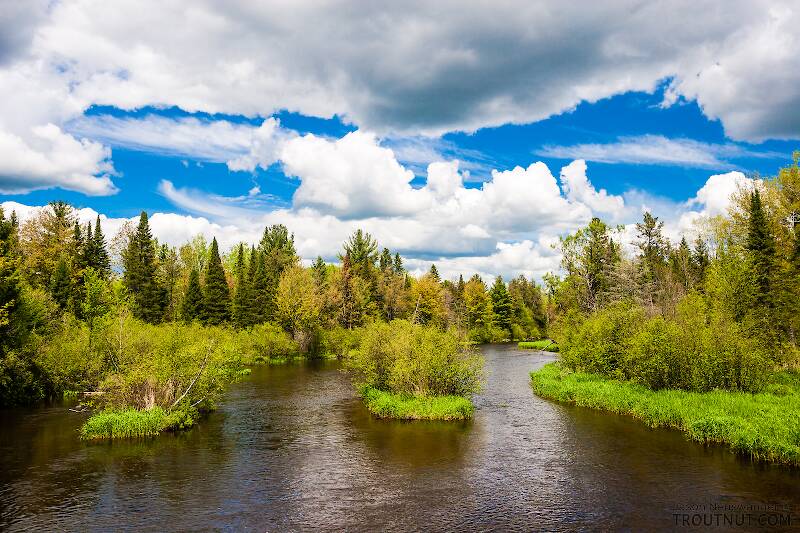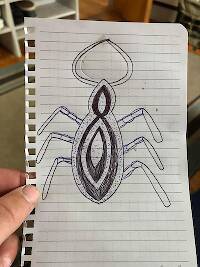
Blue-winged Olives
Baetis
Tiny Baetis mayflies are perhaps the most commonly encountered and imitated by anglers on all American trout streams due to their great abundance, widespread distribution, and trout-friendly emergence habits.
Featured on the forum


Troutnut is a project started in 2003 by salmonid ecologist Jason "Troutnut" Neuswanger to help anglers and
fly tyers unabashedly embrace the entomological side of the sport. Learn more about Troutnut or
support the project for an enhanced experience here.
DOS on Feb 25, 2009February 25th, 2009, 9:20 am EST
Hello,
I'm Drew and have been a long time lurker; today, first time poster.
Yesterday I couldn't take it anymore, steelheading simply was not itching my summertime trout stream fix! The sun was shining and there was not a cloud in the sky, so I filled the gas tank and pointed my aging Buick in the direction of my favorite creek.
Despite the temperature hovering in the low 20's, it was quite a beautiful day. I left the fly rod at home so I could concentrate on capturing some quality picture and video of the insects. I have recently purchased a Nikon D90 and have been thrilled with its capabilities.
The water temperature was at 34f and I did most of my collecting from a lip on the head of a pool in about 10-15 inches of water. The bottom substrate was a mix of silt, small gravel, dinner plate size flat rocks and some aquatic vegetation. I found the highest concentration of insects in the fine silt and gravel buried under the larger rocks, nearest the aquatic vegetation.
Some of the insects feature include:
Stoneflies - Capnia genus and Agnetina capitata
Mayflies - Heptageniid family, Ephemerella and Isonychia genus
Caddis Larva - Hydropsychide and Limnephilidae family
Crane Fly Larva
Video hosted on VIMEO
http://www.vimeo.com/3359287

Hope you enjoy,
Drew
I'm Drew and have been a long time lurker; today, first time poster.
Yesterday I couldn't take it anymore, steelheading simply was not itching my summertime trout stream fix! The sun was shining and there was not a cloud in the sky, so I filled the gas tank and pointed my aging Buick in the direction of my favorite creek.
Despite the temperature hovering in the low 20's, it was quite a beautiful day. I left the fly rod at home so I could concentrate on capturing some quality picture and video of the insects. I have recently purchased a Nikon D90 and have been thrilled with its capabilities.
The water temperature was at 34f and I did most of my collecting from a lip on the head of a pool in about 10-15 inches of water. The bottom substrate was a mix of silt, small gravel, dinner plate size flat rocks and some aquatic vegetation. I found the highest concentration of insects in the fine silt and gravel buried under the larger rocks, nearest the aquatic vegetation.
Some of the insects feature include:
Stoneflies - Capnia genus and Agnetina capitata
Mayflies - Heptageniid family, Ephemerella and Isonychia genus
Caddis Larva - Hydropsychide and Limnephilidae family
Crane Fly Larva
Video hosted on VIMEO
http://www.vimeo.com/3359287

Hope you enjoy,
Drew
Andrew Nisbet
Taxon on Feb 25, 2009February 25th, 2009, 1:12 pm EST
Drew-
Just change IMG to img and /IMG to /img
Just change IMG to img and /IMG to /img
DOS on Feb 25, 2009February 25th, 2009, 2:01 pm EST
Andrew Nisbet
Taxon on Feb 25, 2009February 25th, 2009, 3:27 pm EST
Drew-
Your video was nicely done, and it appears you know your insects.
Your video was nicely done, and it appears you know your insects.
DOS on Feb 25, 2009February 25th, 2009, 3:34 pm EST
Thank again Roger, I have sites like this and yours to thank for my limited bug knowledge! oh and without my boy Patrick McCafferty and his "Aquatic Entomology" i'd be completely lost.
Andrew Nisbet
Freepow on Mar 1, 2009March 1st, 2009, 3:49 am EST
Your video was really well done...I like the quick transitions near the end. Also, I know it was Eddie Vedder, but what was the song titled? My cabin fever is officially at a boil!
"I fish...because I suspect that men are going along this way for the last time, and I for one don't want to waste the trip..."
DOS on Mar 1, 2009March 1st, 2009, 8:19 am EST
Thanks Freepow,
The song is from the "Into the Wild" soundtrack, Eddie Vedder wrote and preforms all 13 tracks... Its a must have if you liked the song, every track is amazing, really capturing the essence of the movie. I think the song name is "Rise" if I remember correctly.
here is a link to listen to samples from the album on Amazon
http://www.amazon.com/gp/recsradio/radio/B000ULQV0W/ref=pd_krex_listen_dp_img?ie=UTF8&refTagSuffix=dp_img
The song is from the "Into the Wild" soundtrack, Eddie Vedder wrote and preforms all 13 tracks... Its a must have if you liked the song, every track is amazing, really capturing the essence of the movie. I think the song name is "Rise" if I remember correctly.
here is a link to listen to samples from the album on Amazon
http://www.amazon.com/gp/recsradio/radio/B000ULQV0W/ref=pd_krex_listen_dp_img?ie=UTF8&refTagSuffix=dp_img
Andrew Nisbet
JZord on Mar 5, 2009March 5th, 2009, 8:07 am EST
that is a really cool video. i was really amazed. Thanks
GONZO on Mar 23, 2009March 23rd, 2009, 2:57 am EDT
Hi Drew,
Nice job on the video. Like Roger, I applaud your interest in aquatic entomology. Even when it doesn't contribute to more fish caught, I find that learning more about the critters that trout eat helps to make the whole experience richer and even more fascinating.
FWIW, I thought you might like to know that the large "golden stones" (pictured above) that star in your video are Agnetina capitata rather than Acroneuria species. The Ephemerella nymphs are probably subvaria. (E. invaria is very similar, but considering the time of year, the nymphs seem too large to be that species.) From what I can see of the ventral markings of the large heptageniid in your last picture above, I would guess that it is probably Maccaffertium vicarium rather than Stenacron. (The dark ventral markings on most Stenacron are restricted to spots or shading along the lateral margins or at the rear.)
Best,
Lloyd
Nice job on the video. Like Roger, I applaud your interest in aquatic entomology. Even when it doesn't contribute to more fish caught, I find that learning more about the critters that trout eat helps to make the whole experience richer and even more fascinating.
FWIW, I thought you might like to know that the large "golden stones" (pictured above) that star in your video are Agnetina capitata rather than Acroneuria species. The Ephemerella nymphs are probably subvaria. (E. invaria is very similar, but considering the time of year, the nymphs seem too large to be that species.) From what I can see of the ventral markings of the large heptageniid in your last picture above, I would guess that it is probably Maccaffertium vicarium rather than Stenacron. (The dark ventral markings on most Stenacron are restricted to spots or shading along the lateral margins or at the rear.)
Best,
Lloyd
DOS on Mar 23, 2009March 23rd, 2009, 3:59 am EDT
Thank you very much for the help Lloyd!!! I can't tell you how thankful I am that there is such a great group of guys on this site willing to offer up guidance. I think the greatest lesson I've learned so far is how humbling it can be to try and sort out all these taxonomic variations!
Now that you have pointed out the correct genus and species, its quite clear to me why its Agnetina and not Acroneuria.
Just yesterday I fished out several of these nymphs from my aquarium for some additional photographs.
here is a better picture of the heptageniid, perhaps it will help to confirm your diagnosis of vicarium.

and the Agnetina capitata

Thanks again Lloyd and all who have helped me so far and I hope will continue to do so.
Now that you have pointed out the correct genus and species, its quite clear to me why its Agnetina and not Acroneuria.
Just yesterday I fished out several of these nymphs from my aquarium for some additional photographs.
here is a better picture of the heptageniid, perhaps it will help to confirm your diagnosis of vicarium.
and the Agnetina capitata
Thanks again Lloyd and all who have helped me so far and I hope will continue to do so.
Andrew Nisbet
GONZO on Mar 23, 2009March 23rd, 2009, 4:18 am EDT
My pleasure, Drew. And yes, that does look like Maccaffertium vicarium to me. The photo shows the truncated tips on gills 1-6 that distinguish the genus, and the dorsal markings are fairly typical of the species. The relative maturity--which is usually accelerated in aquaria--also helps to support the identification.
LittleJ on Mar 23, 2009March 23rd, 2009, 7:27 am EDT
does the wing case on the mac. Blacken before it hatches? Or would a nymph tied with a ginger wing case work through the hatch.
Thanks
Jeff
Thanks
Jeff
GONZO on Mar 23, 2009March 23rd, 2009, 7:51 am EDT
Yes, darkened wingpads generally indicate readiness to emerge in mayfly nymphs, often within a day or so. However, the significance of imitating that feature is for you and (especially) the trout to decide. :)
Quick Reply
Related Discussions
Topic
Replies
Last Reply
0
Aug 12, 2012
by Hdhungryman
by Hdhungryman
1
Aug 22, 2006
by Taxon
by Taxon
9
Jun 16, 2011
by Jmd123
by Jmd123
6
Apr 17, 2013
by Sayfu
by Sayfu



